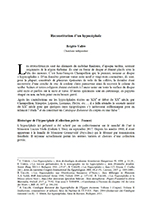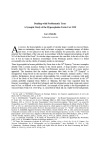Hypocephalus
« Reconstitution d’un hypocĂ©phale »
ENiM 11, 2018, p. 183-195.
 En découvrant le grand fragment d’un hypocéphale d’une collection privée, nous avons immédiatement eu envie de le reconstituer à la lumière du corpus déjà établi : aventure passionnante pour retrouver l’intégrité de l’objet et lui redonner tout son rayonnement et… ses pouvoirs magiques !
En découvrant le grand fragment d’un hypocéphale d’une collection privée, nous avons immédiatement eu envie de le reconstituer à la lumière du corpus déjà établi : aventure passionnante pour retrouver l’intégrité de l’objet et lui redonner tout son rayonnement et… ses pouvoirs magiques !
 Discovering a large fragment of a hypocephalus in a private collection, we immediately began to reconstitute it according to the so far existent corpus : an exciting undertaking to rebuild the complete object to its lustre and its magical powers.
Discovering a large fragment of a hypocephalus in a private collection, we immediately began to reconstitute it according to the so far existent corpus : an exciting undertaking to rebuild the complete object to its lustre and its magical powers.
 Consulter cet article (34898) -
Consulter cet article (34898) -  Télécharger cet article au format pdf (17816)
Télécharger cet article au format pdf (17816)
« Dealing with Problematic Texts. A Synoptic Study of the Hypocephalus Turin Cat. 2320 »
ENiM 12, 2019, p. 49-73.
 Une étude des textes de l’hypocéphale Turin Cat. 2320, probablement daté de la période ptolémaïque, est présentée dans cet article en considérant les variantes dans autres exemplaires. D’autres types de textes autour du bord des hypocéphales, par exemple ceux consacrés à Djebaty, ou comportant des extraits du chapitre 162 du Livre des Morts, présentent des significations plus canoniques. Des références intéressantes aux principales composantes du défunt – ka, ba, akh et le corps – peuvent être identifiées dans les textes autour du bord et dans les divers registres. Particulièrement intéressant est le concept de ba d’Amon qui devient la multiplicité de l’univers et qui, comme l’a souligné Jan Assmann, a été dérivé par les prêtres thébains de la période ramesside de l’idée amarnienne de « un et un million ».
Une étude des textes de l’hypocéphale Turin Cat. 2320, probablement daté de la période ptolémaïque, est présentée dans cet article en considérant les variantes dans autres exemplaires. D’autres types de textes autour du bord des hypocéphales, par exemple ceux consacrés à Djebaty, ou comportant des extraits du chapitre 162 du Livre des Morts, présentent des significations plus canoniques. Des références intéressantes aux principales composantes du défunt – ka, ba, akh et le corps – peuvent être identifiées dans les textes autour du bord et dans les divers registres. Particulièrement intéressant est le concept de ba d’Amon qui devient la multiplicité de l’univers et qui, comme l’a souligné Jan Assmann, a été dérivé par les prêtres thébains de la période ramesside de l’idée amarnienne de « un et un million ».
 A study of the texts in the hypocephalus Turin Cat. 2320, probably dated to the Ptolemaic period, is presented in this paper considering variants in other examples. Other types of texts around the rim of hypocephali, for example those devoted to Djebaty, or with excerpts from spell 162 of the Book of the Dead, present more canonical meanings. Interesting references to the main components of the deceased – ka, ba, akh, and the corpse – can be identified in the texts around the rim and in the various registers. Noteworthy, in particular, is the concept of the ba of Amun that becomes the multiplicity of the universe, which, as Jan Assmann indicated, the Theban clergy of the Ramesside period developed from the Amarnian idea of “One-and-million”.
A study of the texts in the hypocephalus Turin Cat. 2320, probably dated to the Ptolemaic period, is presented in this paper considering variants in other examples. Other types of texts around the rim of hypocephali, for example those devoted to Djebaty, or with excerpts from spell 162 of the Book of the Dead, present more canonical meanings. Interesting references to the main components of the deceased – ka, ba, akh, and the corpse – can be identified in the texts around the rim and in the various registers. Noteworthy, in particular, is the concept of the ba of Amun that becomes the multiplicity of the universe, which, as Jan Assmann indicated, the Theban clergy of the Ramesside period developed from the Amarnian idea of “One-and-million”.
 Consulter cet article (34401) -
Consulter cet article (34401) -  Télécharger cet article au format pdf (17238)
Télécharger cet article au format pdf (17238)
ENiM 18 - 2025
4 article(s) - 11 mars 2025.
ENiM 1 à 18 (2008-2025) : 223 articles
4 019 392 téléchargements
8 332 104 consulations.
Index des auteurs

Mots clés

Derniers articles : 
Robert Steven Bianchi
Duplication and Continuity
(ENiM 18, p. 13-36 — 11 mars 2025) 
Frédéric Mougenot
Rénénoutet à la porte de la maison
(ENiM 18, p. 1-12 — 29 janvier 2025) 
CENiM - Mise en ligne des volumes Ă©puisĂ©s : 
 Anne-Sophie von BOMHARD DĂ©cans Ă©gyptiens, CENiM 23, Montpellier, 2020 — (2020)
Anne-Sophie von BOMHARD DĂ©cans Ă©gyptiens, CENiM 23, Montpellier, 2020 — (2020) 
 Jean-Claude Grenier L'Osiris ANTINOOS, CENiM 1, Montpellier, 2008 — (26 dĂ©cembre 2008)
Jean-Claude Grenier L'Osiris ANTINOOS, CENiM 1, Montpellier, 2008 — (26 dĂ©cembre 2008) 
TDENiM - Mise en ligne des volumes Ă©puisĂ©s : 
 Twitter
Twitter 3615151 visites - 4407 visite(s) aujourd’hui - 160 connecté(s)
© ENiM - Une revue d’égyptologie sur internet
Équipe Égypte Nilotique et Méditerranéenne - UMR 5140 - « Archéologie des Sociétés Méditerranéennes » (Cnrs) - Université Paul Valéry - Montpellier III























 Contact
Contact
 Abonnez-vous !
Abonnez-vous ! Équipe Égypte Nilotique et Méditerranéenne
Équipe Égypte Nilotique et Méditerranéenne UMR 5140 « Archéologie des Sociétés Méditerranéennes » (Cnrs)
UMR 5140 « Archéologie des Sociétés Méditerranéennes » (Cnrs) Université Paul Valéry - Montpellier III
Université Paul Valéry - Montpellier III